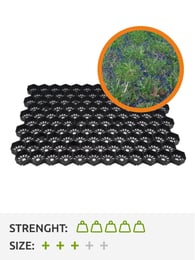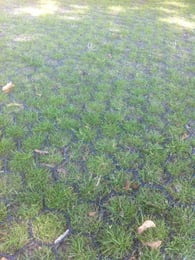
Grass grids
Grass grids, also known as grass driveway grids, are the ideal tool for creating the perfect lawn or grass field. They also provide perfect stability when it comes to grass fields facing certain levels of pressure. This means our grass grids can be used for driveways and parking lots.
When to use grass grids?
Plastic grass grids are particularly beneficial when a grass surface is regularly subjected to high amounts of pressure. This includes scenarios such as garden paths, grass parking areas, and grass driveways. However, grass grids can also be valuable when you want to create a beautiful and neat lawn or grass field, especially in areas that experience heavy foot traffic.
Grass Grids: advantages and disadvantages
Using grass grids offers several advantages. Here are the main benefits:
- Grass grids provide more stability to a grass surface, preventing sinking, holes, and rutting, provided a good foundation layer is also installed. The grass grids themselves can withstand a load of over 600 tons per square meter.
- A neater grass surface. When you use grass grids for the installation of, for example, a lawn or grass field, this ensure a smoother overall appearance.
- Reduced pooling of water on the surface. The holes in the grass grids allow excess rainwater to drain away more quickly.
There aren't any significant downsides to using grass grids. Of course, it involves a small investment and takes some time to install the grass grids. However, in return, you'll get a beautiful and neat (lasting) grass surface. It's important to allow the grass some time to settle after placing/sowing it into the grass grids, typically around four weeks. Additionally, some maintenance is advisable.
How to install and seed plastic grass grids
Installing the grass grids is relatively simple due to the coupling system. When the surface is going to be exposed to high pressure, we recommend laying a foundation layer of 15cm to 50cm (depending on the load), such as crushed stone. After leveling the foundation, you can optionally apply a leveling layer of, for example, sand. If you choose to do this, we strongly recommend applying weed control fabric to make the whole surface more maintenance-friendly. Then, install the grass grids on top. Fill the grass grids with a mixture of topsoil (40%) and (crusher) sand (60%) until about 0.5cm below the edge. Then, you can sow grass seeds and apply water. Regarding the amount of time it takes to install our grass grids: this naturally varies from person to person, but the average processing speed is about 100sqm per hour (note: this only applies to laying the grass grids, not to installing any foundation etc.).
How many grass grids do I need?
You'll need 1.79 grass grids per square meter. But please note: orders are placed per square meter. You specify the number of square meters you need, and we'll calculate how many grass grids are necessary.














